- Home
- Common Shoulder Problems
- Impingement Syndrome
- Exercises
Shoulder Impingement Exercises
Written By: Chloe Wilson BSc (Hons) Physiotherapy
Reviewed By: SPE Medical Review Board
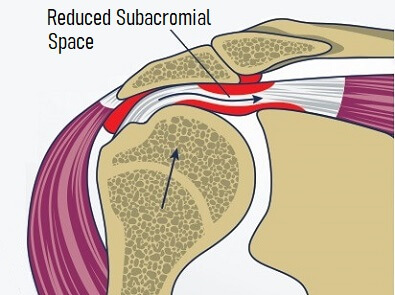
Shoulder impingement exercises are one of the best ways to treat impingement syndrome.
Impingement syndrome is the most common cause of shoulder pain, affect around 1 in 5 people, most commonly starting in middle age between the ages of 45-65.
Shoulder impingement syndrome develops when there is narrowing of the gap between the shoulder blade and shoulder bone, known as the subacromial space. This may be from bone spurs, bursitis or shoulder instability.
In most cases of shoulder impingement there is weakness, tightness and poor control around the shoulder which affects how the shoulder joint moves. This increases the pressure and friction through the rotator cuff tendons which leads to swelling and/or causing pain when raising the arm.
One of the best ways to treat impingement is with shoulder impingement exercises to restore the normal movement, strength and control and reduce the friction on the rotator cuff.
Do I Have Impingement Syndrome?
Before starting shoulder impingement exercises, it’s really important to know if impingement syndrome is actually your problem, as there are a number of other common shoulder problems that present similarly.
Common symptoms of shoulder impingement syndrome are:
- Shoulder Pain: sharp, toothache type pain in the shoulder which may radiate down the arm to the elbow but no further
- Painful Arc: the classic symptom of shoulder impingement syndrome is a painful arc of movement which gets gradually worse as you raise your arm towards shoulder height, but once you get high enough, the pain often eases off
- Difficulty Sleeping: it is often painful to lie on the affected shoulder
- Weakness: increasing weakness in the arm
- Functional Activities Limited: twisting movements such as putting on your coat or fastening your bra, reaching to get things out of a high cupboard or hanging up washing may be difficult
You can find out lots more about the causes, symptoms and treatment in the shoulder impingement article.
Tests For Impingement Syndrome
There are two simple tests you can do at home, either by yourself or with some assistance, to see if you do have shoulder impingement syndrome:
1. Empty Can Test
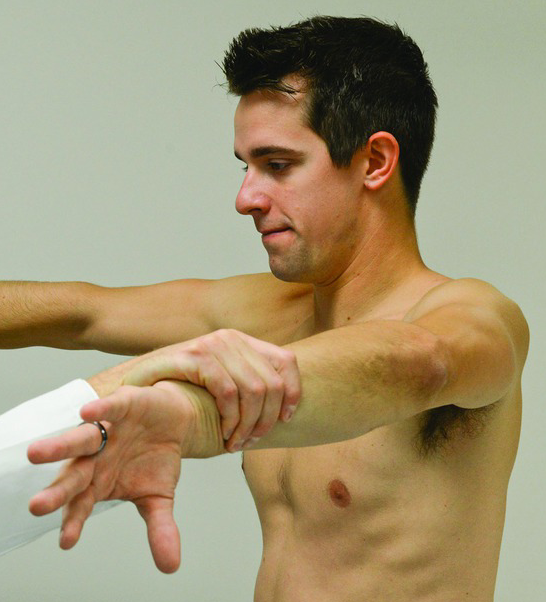
- Raise your arm out to the side to shoulder height, leading the movement with your thumb.
- Bring the arm forwards approx. 30 degrees
- Twist the arm forwards so that your thumb ends up pointing down to the floor.
- Keeping your arm in that position, gently press down through your forearm using your other hand (or ask someone else to help), but resist the movement.
Pain across the top or at the front of the shoulder indicates a positive test for shoulder impingement.
2. Hawkins Kennedy Test

- Start with your elbow bent at 90 degrees by your side
- Raise the elbow, forearm and hand out to the side to shoulder height
- Let the hand slowly drop down and gently press through the back of the wrist with your other hand (or have someone help)
- Bring your upper arm/elbow forwards around 45 degrees and repeat
- Bring the arm forwards to around 90 degrees so the forearm is parallel to your chest and repeat the test.
Pain in any of these three positions indicates shoulder impingement syndrome.
If neither of these tests causes your pain, then it is very unlikely that you have impingement syndrome in which case visit the shoulder pain diagnosis section for help working out what is wrong.
Best Shoulder Impingement Exercises
Shoulder impingement exercises aim to restore the normal movement at the shoulder by regaining strength, stability and mobility. When this is achieved, the shoulder will be able to move freely without excessive friction and pressure on the rotator cuff.
The best shoulder impingement exercise programs will focus on three different areas of exercises:
- Scapular Strengthening Exercises: to ensure the shoulder blade is moving correctly and providing stability
- Stretches: to reduce any tightness and ensure that the shoulder is properly aligned
- Rotator Cuff Exercises: to ensure the muscles can provide adequate strength and control as the arm moves
It is really important that shoulder impingement exercises target each three of these areas if you want to make a full recovery and to ensure that the problem doesn’t return.
In most cases of shoulder impingement, the main issue tends to be pain rather than restriction of movement, but if your movement is severely limited, start with pendulum and active assisted exercises in the shoulder mobility section first and then come back to these shoulder impingement exercises later.
1. Scapular Stability Exercises
Scapular stability exercises for shoulder impingement are the best place to start for pretty much anyone with impingement syndrome. Poor control around the scapula affects how the shoulder blade moves and shifts it out of position which reduced the subacromial space at the top of the shoulder, the primary cause of impingement syndrome. Without good scapular control, anytime you lift your arm you risk pinching the rotator cuff tendons and causing tearing and inflammation.
Scapular Setting
Shoulder impingement exercises targeting scapula stability all start by getting the shoulder blade in the right place and activating the lower traps – the key stabilising muscles of the scapula. This helps draw the shoulder blade down and back, opening up the subacromial space and reducing shoulder impingement. Scapular setting exercises can be done in any position.
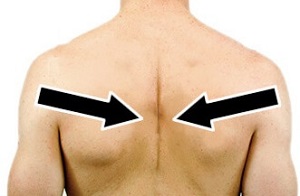
- Start in a good, upright posture
- Draw your shoulder blades back towards your spine, and down towards your buttocks
- Hold for 3-5 seconds and repeat 10-20 times
Top Tips: 1. Imagine a piece of string tied to the bottom corner of your shoulder blade, pulling it towards the opposite back pocket of your trousers
2. The main bulk of the work should come from the lower traps in the area between the lower third of the scapula and the spine.
Scapula Squeeze Strengthening
There are a whole load of possible variations with this shoulder impingement exercise. By changing the arm position, you can gradually challenge the scapular stabilizers to work harder in more functional positions which can really help improve activities of daily living with shoulder impingement
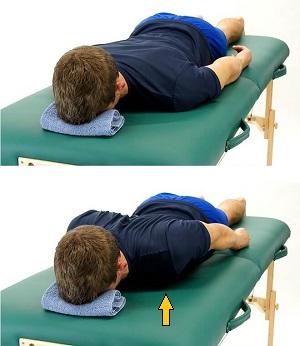
- Lie on your stomach, resting your forehead on a folded towel, arms by your side, palms facing in
- Draw your shoulder blades back and down as with scapular setting exercise feeling the front of the shoulders rise off the bed around 5-8cm. The movement should come from the lower traps region and the neck should stay relaxed
- Initially aim to hold for around 10 seconds but gradually build up to 3 reps of 30 seconds, making sure the shoulder doesn’t drop forwards as the muscle tire
Progressions: You can add in various progressions as you maintain the scapula squeeze
1. Lift the hand up off the bed
2. Pulse the arm up and down as you hold
3. Add a weight
4. Change your arm position – e.g. “W” & “Y” positions - Find Out More >
Wall Press Ups
Wall press ups are one of my favorite shoulder impingement exercises as they are a great way to get back to doing press ups without aggravating your impingement as you aren’t taking all your body-weight through your shoulders.

- Place your hands on a wall around shoulder height with your elbows straight
- Draw your shoulder blades back to set the scapula and slowly bend the elbows as you take your chest to the wall
- Hold for a few seconds and then push back through your arms to the starting position
- Maintain the scapula squeeze position throughout
Progression: Vary your hand position (higher, lower, closer together, further apart) to work the muscles in different positions for greater strength
You can find loads more shoulder blade exercises for shoulder impingement in the scapular stabilization exercises section.
2. Shoulder Impingement Stretches
With stretching exercises for shoulder impingement, you want to start out gently. Initially, hold each stretch for 3-5 seconds and repeat 10-20 times, but the gradually aim to increase how long you hold the stretch for. As you hold for longer, you can reduce the number of repetitions, aiming to get to a 30 second hold, repeated 3 times.
Elbow Flares
Elbows flares are a great exercise for shoulder impingement as they help to stretch out joint capsule, and ensure the shoulder joint sits correctly in its socket.
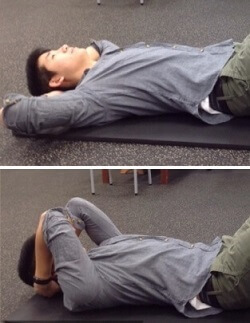
- Lie on your back in a comfortable position and put both hands behind your head
- Stretch the front of your shoulder by letting your elbows drop out to the side, down as close to the bed as is comfortable. Hold for 3-5 seconds
- Stretch the back of your shoulder by bringing your elbows as close together as you can, aiming to get them to touch in front of your nose. Hold for 3-5 seconds
- Repeat 10-20 times in each direction
Door Stretch
The doorway stretch is one of my favorite shoulder impingement exercises as you can change the position of your arms to make it work best for you.

- Stand in an open doorway with one foot in front of the other, through the doorway
- Place both forearms against the door frame with your elbows around shoulder height – find a height that is comfortable for you
- Slowly lunge forwards, bending your front knee until you feel a stretch across the front of your chest/shoulders
- Hold for 3-5 seconds and return to starting position
Monkey Hangs
Hanging from a pull up bar can be a very useful exercise with shoulder impingement as it really helps to open up the space in the joint and reduces pressure and compression on the soft tissues. Some people absolutely swear by it, but it’s not for everyone and does require good range of movement in the shoulder. Chances are, you haven’t done anything like this since swinging on monkey bars as a child, so it’s going to be a challenge and will take time, so take it easy! You might want to come back to this one in a few weeks.
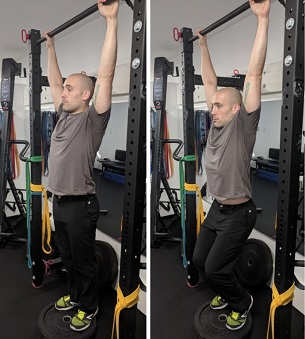
- Stand holding on to a pull up bar with both hands. If your feet don’t touch the ground stand on a sturdy box, stool or chair
- Slowly bend your knees and let your buttocks sink down so you are providing less support through your legs and taking more weight through your arms
- Take it very slowly and gently – you should be able to breathe normally and ease into it rather than being in intense pain
- Start off with short spurts of just a few seconds and gradually build up until you can take more and more weight through your arms for longer
Progressions: 1. Once you feel confident holding this position for 30 seconds, you can try lifting one leg up off the floor, just for a few seconds at first. Again start with small doses and gradually build up e.g. you might lift one leg for 5 seconds, have both legs down for 20 seconds then lift the other leg for 5 seconds and so on
2. Once you can comfortably keep one foot lifted for at least 30 seconds, the final progression is to lift both feet. Again start by doing this just for a few seconds and then put one or both feet down, and gradually hold it for longer as you build your endurance.
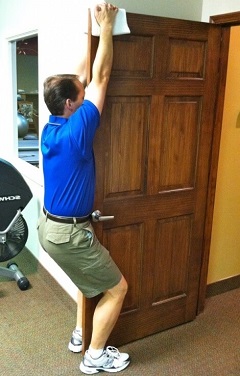
Modifications: If you don’t have a pull up bar, you can do a modified version using a door, provided it is sturdy enough! You won’t be able to fully hang, but you can certainly provide some traction through your shoulders to open up the joint and release the impingement.
- Place your hands over the top of the door on a towel for cushioning and straddle the door with your legs
- Slowly bend your knees feeling the traction through your shoulder and carry out the exercise as described above.
NB keep the door straddled between your legs throughout as you don't want it to move!
Other Stretches That Can Help
There are lots of other stretching exercises that can help with shoulder impingement – check out the
- Shoulder & Arm Stretches: target the rotator cuff, biceps and triceps muscles
- Trapezius Stretches: target the large, superficial muscle that spans the neck and upper back to the shoulder - tight traps is often linked with poor posture
- Upper Back Stretches: help to reduce stiffness in the upper back and shoulder - particularly important if you spend long periods sitting down
3. Shoulder Impingement Strengthening Exercises
Rotator cuff strengthening exercises for shoulder impingement are a really important part of rehab as it is the rotator cuff that control how the upper arm moves. Weakness in the rotator cuff is common with impingement syndrome which puts the tendons at increased risk of damage.
Resistance bands, such as theraband, are a really useful tool with shoulder impingement exercises for improving rotator cuff strength without aggravating the damaged tendon. You can control how much resistance there is from the band by changing where you hold it and they are safer, cheaper and more portable than weights – check out this article on Resistance Bands vs Weights. There are loads of different ways of using resistance bands but here are my favourites for treating shoulder impingement.
Theraband External Rotation
Doing external shoulder rotation with a resistance band combines rotator cuff strengthening and scapula strengthening making it a great shoulder impingement exercise.
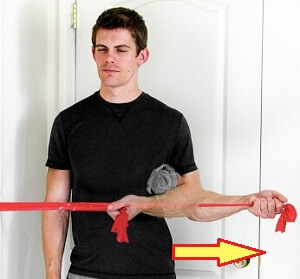
- Tie the theraband securely to a door handle and hold the other end. Bend your elbow and rest it against your waist, palm up
- Set the scapula and then, keeping your elbow tucked in and your wrist locked, pull through the band and twist your arm out to the side, leading the movement with your hand
- Hold for 3 seconds and slowly return to the starting position
Progressions: 1. Hold the band closer to the door handle to increase the resistance
2. Add some small pulses at the end part of the movement before returning to the starting position
Top Tips: 1. Some people find it helps to have a small folded towel between their elbow and waist and to squeeze the towel during the exercise
2. You can always anchor the other end of the band by holding it in your other hand if you don’t have anything to tie it to
Theraband Rowing
Rowing shoulder impingement exercises works the rotator cuff, posterior deltoid, lower traps and triceps all at the same time
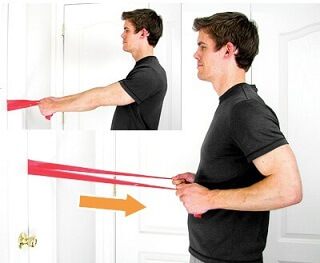
- Tie the middle of the band to a door handle (door closed!) and hold either side, arms out straight, thumbs pointing to the ceiling
- Slowly pull through the band and squeeze the shoulder blades back and down to draw the elbows back in a rowing motion
- Hold for 3-5 seconds and slowly return to the starting position
Progressions: 1. Add some end range pulses
2. Hold the rowing position and then straighten and bend your elbows to work your triceps
3. Take up more slack in the band so you have to pull harder
Shoulder Taps
Shoulder taps is a challenging shoulder impingement exercise that works not only the rotator cuff and scapular stabilisers, but also your core. You are aiming for slow, controlled movement rather than speed.
- Start on all fours, hands directly under your shoulders, knees directly under your hips
- Arch your back up and down a few times and come to rest in the mid position, looking down at the floor with the back of your neck long, and gently draw in your lower tummy muscles
- Slowly lift one hand and tap your opposite shoulder, then bring the hand back down
- Repeat on the other side, aiming for 10-20 reps
Progressions: 1. Hold the shoulder tap position for a few seconds before lowering the arm
2. Perform a mini press up between each shoulder tap
3. Gradually move the starting position of your hands further forwards
Top Tips: 1. Don’t let the body twist or the shoulders drop as you move the arm
2. Keep your core muscles engaged and breathe normally throughout
Advanced Shoulder Impingement Syndrome Exercises
Here I have shared with you my favourite shoulder impingement exercises, the ones I find tend to be most beneficial, but there are loads more exercises that can help.
- Scapular Stabilization Exercises: Loads more shoulder blade strengthening exercises to choose from – these really are the key when it comes to shoulder impingement exercises
- Upper Back Stretches: stiffness and tightness in the upper back often contributes to shoulder problems
- Beginners Rotator Cuff Exercises: These are perfect if you are in a lot of pain, your movement is really restricted or you are finding the exercises here too challenging
- Resistance Band Exercises: Loads of exercises to choose from using resistance bands to help with your shoulder impingement
- Shoulder Stretches: If your movement is restricted or your muscles feel tight, these stretches can really help reduce shoulder impingement
Recovering From Shoulder Impingement
These shoulder impingement exercises are a great way to recover from impingement syndrome and get back to the things you love but don’t expect instant results. It may take 6-12 weeks, sometimes even longer, to get the full benefits from your shoulder impingement exercises during which time you shoulder avoid:
- Overhead Activities: e.g. tennis, throwing a ball, pegging up washing
- Weights: avoid any weights in the gym, particularly any overhead exercises
- Swimming: avoid completely if possible, if not switch to breast stroke rather than front or back crawl
- Aggravating Activities: avoid anything that aggravates your symptoms
With shoulder impingement syndrome it is really important to allow the damaged tendons time to heal, so if something hurts, don’t do it or else you are just slowing down the healing process. You might find that by changing your position, you can do the activity in a slightly different way without impingement pain, but if not, skip it.
If after three months of doing these shoulder impingement exercises you still aren’t seeing any improvement, talk to your doctor. It might be that there is a structural issue such as bone spurs that may require subacromial decompression surgery.
Remember, these exercises may feel difficult at first but they shouldn’t hurt. If any of them do, skip them for a couple of weeks and then try again.
What Else Can Help?
Shoulder impingement exercises are one of the most effective treatments for impingement syndrome but there are lots of other things that can help alongside such as ice, medication, improving posture and steroid injections – find out more about shoulder impingement treatment.
Shoulder impingement is the most common cause of shoulder pain, but there are lots of other things that can go wrong. If you want some help working out what is wrong, visit the shoulder pain diagnosis section or check out our article on common causes of shoulder pain. You may also be interested in the following articles:
- Shoulder Clicking & Popping
- Shoulder Pain When Lifting Your Arm
- Shoulder Pain At Night
- Burning Shoulder Pain
- Upper Arm Pain
Page Last Updated: 12/12/2023
Next Review Due: 12/12/2025


